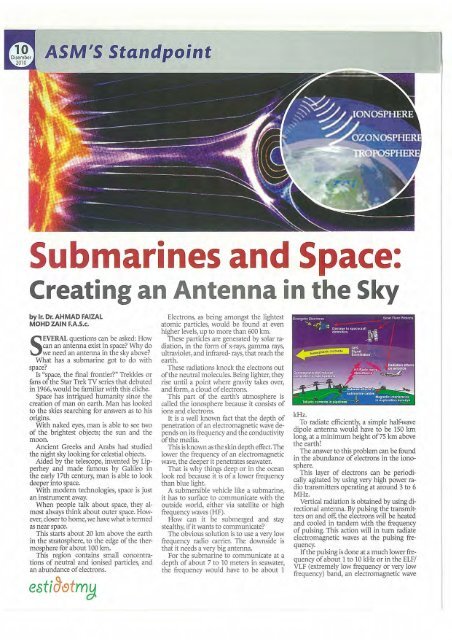1 - Akademi Sains Malaysia
1 - Akademi Sains Malaysia
1 - Akademi Sains Malaysia
You also want an ePaper? Increase the reach of your titles
YUMPU automatically turns print PDFs into web optimized ePapers that Google loves.
Submarines and Space:<br />
Creating an Antenna in the Sky<br />
by In Dr. AHMAD FAIZAL<br />
MOHD ZAIN F.A.S.c.<br />
SEVERAL questions can be asked: How<br />
can an antenna exist in space Why do<br />
we need an antenna in the sky above<br />
What has a submarine got to do with<br />
space<br />
Is "space, the final frontier" Trekkies or<br />
fans of the Star Trek TV series that debuted<br />
in 1966, would be familiar with this cliche.<br />
Space has intrigued humanity since the<br />
creation of man on earth. Man has looked<br />
to the skies searching for answers as to his<br />
origins.<br />
With naked eyes, man is able to see two<br />
of the brightest objects; the sun and the<br />
moon.<br />
Ancient Greeks and Arabs had studied<br />
the night sky looking for celestial objects.<br />
Aided by the telescope, invented by Lipperhey<br />
and made famous by Galileo in<br />
the early 17th century, man is able to look<br />
deeper into space.<br />
With modem technologies, space is just<br />
an instrument away.<br />
When people talk about space, they almost<br />
always think about outer space. However,<br />
closer to home, we have what is termed<br />
as near space.<br />
This starts about 20 km above the earth<br />
in the stratosphere, to the edge of the thermosphere<br />
for about 100 km.<br />
This region contains small concentrations<br />
of neutral and ionised particles, and<br />
an abundance of electrons.<br />
esfiJotmg<br />
Electrons, as being amongst the lightest<br />
atomic particles, would be found at even<br />
higher levels, up to more than 600 km.<br />
These particles are generated by solar radiation,<br />
in the form of x-rays, gamma rays,<br />
ultraviolet, and infrared- rays, that reach the<br />
earth.<br />
These radiations knock the electrons out<br />
of the neutral molecules. Being lighter, they<br />
rise until a point where gravity takes over,<br />
and form, a cloud of electrons.<br />
This part of the earth's atmosphere is<br />
called the ionosphere because it consists of<br />
ions and electrons.<br />
It is a well known fact that the depth of<br />
penetration of an electromagnetic wave depends<br />
on its frequency and the conductivity<br />
of the media.<br />
This is known as the skin depth effect. The<br />
lower the frequency of an electromagnetic<br />
wave, the deeper it penetrates seawater.<br />
That is why things deep or in the ocean<br />
look red because it is of a lower frequency<br />
than blue light.<br />
A submersible vehicle like a submarine,<br />
it has to surface to communicate with the<br />
outside world, either via satellite or high<br />
frequency waves (HF).<br />
How can it be submerged and stay<br />
stealthy, if it wants to communicate<br />
The obvious solution is to use a very low<br />
frequency radio carrier. The downside is<br />
that it needs a very big antenna.<br />
For the submarine to communicate at a<br />
depth of about 7 to 10 meters in seawater,<br />
the frequency would have to be about I<br />
kHz.<br />
To radiate efficiently, a simple half-wave<br />
dipole antenna would have to be 150 km<br />
long, at a minimum height of 75 kin above<br />
the earth!<br />
The answer to this problem can be found<br />
in the abundance of electrons in the ionosphere.<br />
This layer of electrons can be periodically<br />
agitated by using very high power radio<br />
transmitters operating at around 3 to 6<br />
MHz.<br />
Vertical radiation is obtained by using directional<br />
antenna. By pulsing the transmitters<br />
on and off, the electrons will be heated<br />
and cooled in tandem with the frequency<br />
of pulsing. This action will in turn radiate<br />
electromagnetic waves at the pulsing frequency.<br />
If the pulsing is done at a much lower frequency<br />
of about 1 to 10 kHz or in the ELF/<br />
VLF (extremely low frequency or very low<br />
frequency) band, an electromagnetic wave

















